With nine finger stumps to the top of Everest?
It has gone out of style to climb Mount Everest in fall. This happened even though some of the most spectacular summit successes on the highest mountain in the world have been made in the post-monsoon period: Remember only the first ascent through the Everest Southwest Face by the British Doug Scott and Dougal Haston in September 1975 or the success of the US-American Carlos Buhler, Kim Momb and Lou Reichardt via the East Face in October 1983. However, the climbing season has moved more and more into spring since commercial expeditions have taken over on Everest – due to higher temperatures compared to fall and to the usually lower risk of avalanches. Since 2000, only 36 summit successes have been recorded in September or October – next to nothing compared with over 5,000 ascents in spring since the turn of the millennium. The last ascent to the top of Everest in fall dates from five years ago: In October 2010, the American Eric Larsen and five Sherpas reached the highest point at 8,850 meters. This fall, there will be another attempt to climb Everest from the Nepalese south side. According to the “Himalayan Times” the so-called “Icefall Doctors” – a group of high specialized Sherpas – arrived at Base Camp in order to fix a route through the Khumbu Icefall.
Kuriki’s comeback
The Japanese Nobukazu Kuriki and Masaru Kadotani want to scale Everest in fall, the newspaper reports referring to Tika Ram Gurung, head of the Nepalese expedition operator Bochi-Bochi Trek. In fall 2010, Kuriki had tried to climb Everest solo without bottled oxygen via the rarely used West Ridge. The then 30-year-old said that he had to turn back at about 8,000 meters because of a storm. On his descent, Kuriki sent an emergency call. Sherpas climbed up to him, and the Japanese was flown by rescue helicopter from Camp 2 at 6,400 meters to a hospital in Kathmandu. Kuriki suffered severe frostbite. Nine fingers had to be amputated; only stumps were left. Nevertheless, the Japanese did not want to bury his dream of adventures on eight-thousanders.
In July 2014, Nobukazu claimed to have scaled Broad Peak in Pakistan without breathing mask (look at his summit video below). Actually, Kuriki planned to tackle Mount Everest from the Tibetan north side this fall. But the Chinese authorities put a spoke in his wheel by announcing that they will not give any expedition permit for Tibet before spring 2016.
South Korean Lhotse Expedition
The Icefall Doctors will prepare the route not only for the Japanese. According to Gyanendra Shrestra from the Tourism Ministry, a South Korean team wants to climb Lhotse in fall. Twice in a row, spring season on Mount Everest has been stopped prematurely: In 2014 after the avalanche in the Khumbu Icefall that killed 16 Nepalese climbers, this year after the devastating earthquake in Nepal. The tremors triggered an avalanche, at least 18 people died in Base Camp.









